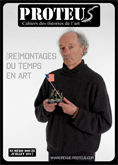Du commentaire fictif pour remonter les archives - Puissances du faux chez Harun Farocki
Abstract
 Télécharger l’article
Télécharger l’article
Paru dans : Proteus n°12

Comment la fiction peut-elle être un moyen cinématographique « adéquat » pour reprendre les archives dans un film documentaire ? Comment peut-elle constituer une démarche respectueuse des images, quand bien même les images reprises seraient des archives des camps ? Cet article se propose d’interroger les vertus ou « puissances du faux » dans deux séquences de films de Harun Farocki, afin de saisir les qualités du commentaire fictif pour remonter les archives. Il s’agira d’observer combien le cinéma documentaire dispose de choix formels osés et audacieux, dont la justesse et la perspicacité indiquent l’horizon esthétique d’un cinéma à même de mettre en jeu les images de l’histoire, et de les donner à voir.
Mots-clés : montage — document — fiction — commentaire
How can fiction be a "proper" way to retake archives in a documentary movie? Can it be an approach respectful of the images, even if they are images of the concentration camps? This article will investigate on two filmstrips where Harun Farocki retake archives with the "powers of the false" in order to understand what are the qualities of a fictional commentary when editing the archives. It intends to observe the aesthetic choices (both daring and appropriate) the documentary cinema possess, and its ability to produce an history film able to put the archives at stake.
Keywords: editing — document — fiction — commentary








